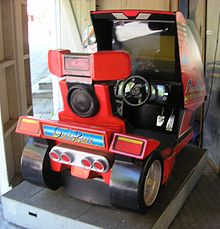Out Run
The digital 80's
I loved games, and in my infancy I used to be an "adult playing observer", passing hours watching people inserting 25 peseta coins for additional lifespan in Gauntlet, or trying to consume all Out Run's in-game melodies and the colorful USA-wide scroll. Defender, Space Invaders, Galaxian or Donkey Kong are the first ones I remember, full of charm, in bars, mini-golf resources, or swimming pools near León, with a delicious smell to tapas.
Out Run (アウトラン, Auto Ran) (also spelled OutRun and Outrun) is an arcade game released by Sega in 1986. It was designed by Yu Suzuki and developed by Sega-AM2. The game was a critical and commercial success, becoming one of the best-selling video games of its time and winning the Golden Joystick Award for Game of the Year. It is notable for its innovative hardware (including a moving cabinet), pioneering graphics and music, innovative features such as offering the player choices in both soundtrack and non-linear routes, and its strong theme of luxury and relaxation. In retrospective interviews, Yu Suzuki has classified Out Run not as a racing game, but as a "driving" game.
Out Run is a 2D third-person racing game. The player controls a car, a Ferrari Testarossa, from a rear third-person perspective. The player must race to the end of each stage as fast as possible against a time limit while avoiding traffic. At the end of each stage, the player is presented with a fork in the road where the player must choose one of two stages. The left route presents an easier stage, while the right offers a greater challenge. Passing through checkpoints awards the player with extra time. Once the timer reaches zero or the player completes the race, the game ends. In addition to the nonlinear gameplay, Out Run also offered the choice of music to listen to while driving, represented as radio stations.
The arcade game features raster graphics on a color CRT monitor and amplified stereophonic sound. There are a total of four cabinet designs (two upright and two sit-down), all of which are equipped with a steering wheel with force feedback, a stick shift plus acceleration and brake pedals. The upright cabinet came in two versions: Normal and Mini. The sit-down cabinets resembled the in-game car and used a drive motor to move the main cabinet — turning and shaking according to the onscreen action. There were two versions of the sit down: the Deluxe version featured a 26-inch color monitor and a custom molded seat, while the Standard featured a more simplified design and a 20-inch color monitor.
Keywords:
16-bit
2.5D
2D computer graphics
68000
8-bit
ACE (games magazine)
Acceleration
After Burner
Alex Kidd
Alps
Amiga
Amstrad CPC
Amusement arcade
Arcade cabinet
Arcade game
Atari ST
Battle Out Run
Billy Hatcher and the Giant Egg
Bonanza Bros.
Border Break
Brake
Bubble Bobble
Casiopea
Central Processing Unit
Chu Chu Rocket!
Columns (video game)
Commodore 128
Commodore 64
Commodore Amiga
Commodore International
Compact Cassette
Computer and Video Games
Computing platform
Crash (magazine)
Crash magazine
Crazy Taxi (series)
Daytona USA (video game)
Derby Owners Club
Dinosaur King
Distinctive Software
Dragon (magazine)
Dreamcast
Europe
FM Radio
Fantasy Zone
Ferrari F355 Challenge
Ferrari Testarossa
Finland
Football Manager
Force feedback
Game Boy Advance
Game designer
Game of the Year
GameFAQs
Golden Axe (series)
Golden Joystick Award
Golden Joystick Awards
Hang-On
Hiroshi Miyauchi
History of video game consoles (fourth generation)
History of video game consoles (third generation)
Home computer
Initial D Arcade Stage
Japan
Jet Set Radio
Killer List of Videogames
List of Sega video game franchises
List of best-selling PC video games
List of best-selling video games
List of highest-grossing arcade games
Los Angeles, California
MSX
MSX2
MTV
Mega Drive
Miami Sound Machine
Microsoft Windows
Mobile Phone
NEC Corporation
New York City
Nights into Dreams...
Nonlinear gameplay
North America
Out Run
Out Run 2
Out Run 2019
Out Run Europa
OutRun 2
OutRun Online Arcade
OutRunners
Outrun Online Arcade
Outrunners
PC game
PC-DOS
Panzer Dragoon (series)
Personal computer
Phantasy Star
Platoon (video game)
PlayStation 2
PlayStation Network
PlayStation Portable
Puyo Puyo (series)
Racing game
Racing video game
Raster graphics
Renegade (video game)
Ristar
S.S.T. Band
SIMS Co., Ltd.
Sakura Wars
Samba de Amigo
Sangokushi Taisen
Sega
Sega 3-D Glasses
Sega AM2
Sega Ages
Sega Bass Fishing
Sega Game Gear
Sega Master System
Sega Rally
Sega Saturn
Sega Superstars (series)
Sega Superstars Tennis
Sega System 32
Sega-AM2
Shenmue (series)
Shenmue II
Shining (series)
Shinobi (series)
Sim racing
Sinclair Research Ltd
Sinclair User
Single player
Skies of Arcadia
Sonic & All-Stars Racing Transformed
Sonic the Hedgehog (series)
Soundtrack
Space Channel 5
Space Harrier
Sprite (computer graphics)
Starhorse
Steering wheel
Stereophonic sound
Stereoscopic
Stick shift
Stonehenge
Streets of Rage (series)
Super Monkey Ball (series)
Swedish language
The Games Machine
The House of the Dead (series)
The Last Ninja
The Video Game Critic
Third person (video games)
Tilt (magazine)
Total War (series)
Turbo Out Run
TurboGrafx-16
U.S. Gold
Valkyria Chronicles
Video game arcade cabinet
Video game console
Video game developer
Video game genres
Video game music
Video game publisher
Virtua Cop
Virtua Fighter (series)
Virtua Racing
Virtua Striker
Virtua Tennis
Virtual On
Windmill
Wonder Boy
World Club Champion Football
World of Spectrum
Xbox
Xbox Live Arcade
Yakuza (series)
Your Sinclair
Yu Suzuki
Z80
ZX Spectrum
Content extracted from Wikipedia, where you can find its license details.
Ignacio Javier Gómez Rodríguez (igjav). OS developer. Naive power.



